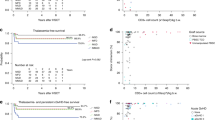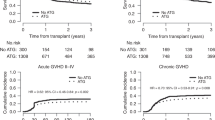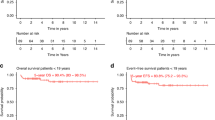Abstract
The risk of hypothyroidism after reduced-intensity hematopoietic cell transplantation (HCT) is not well known. We studied the incidence of hypothyroidism among a cohort of HCT recipients who had survived for ⩾1 year and received a TBI-based myeloablative (MA) (N=84) or reduced-intensity (N=97) conditioning (RIC) regimen. MA HCT recipients were younger at the time of transplant (median age 37 vs 54 years, P<0.01), otherwise the two groups were comparable. Median follow-up was 28 (range, 12–75) months for MA and 25 (range, 12–67) months for RIC group. The 3-year cumulative incidence of hypothyroidism was 8 and 5%, respectively (P=0.41). In multivariate analysis, both types of conditioning regimens were associated with similar risks for hypothyroidism (relative risk for MA 1.6 vs RIC). At least in the first few years after HCT, the risks for hypothyroidism are similar among patients receiving TBI-based MA and reduced-intensity regimens.
This is a preview of subscription content, access via your institution
Access options
Subscribe to this journal
Receive 12 print issues and online access
$259.00 per year
only $21.58 per issue
Buy this article
- Purchase on Springer Link
- Instant access to full article PDF
Prices may be subject to local taxes which are calculated during checkout

Similar content being viewed by others
References
Boulad F, Bromley M, Black P, Heller G, Sarafoqlou K, Gillio A et al. Thyroid dysfunction following bone marrow transplantation using hyperfractionated radiation. Bone Marrow Transplant 1995; 15: 71–76.
Al-Fiar FZ, Colwill R, Lipton JH, Fyles G, Spaner D, Messner H . Abnormal thyroid stimulating hormone (TSH) levels in adults following allogeneic bone marrow transplants. Bone Marrow Transplant 1997; 19: 1019–1022.
Sklar CA, Kim TH, Ramsay NK . Thyroid dysfunction among long-term survivors of bone marrow transplantation. Am J Med 1982; 73: 688–694.
Michel G, Socie G, Gebhard F, Bernaudin F, Thuret I, Vannier JP et al. Late effects of allogeneic bone marrow transplantation for children with acute myeloblastic leukemia in first complete remission: The impact of conditioning regimen without total-body irradiation—a report from the societe francaise de greffe de moelle. J Clin Oncol 1997; 15: 2238–2246.
Ishiguro H, Yasuda Y, Tomita Y, Shinagawa T, Shimuzu T, Morimoto T et al. Long-term follow-up of thyroid function in patients who received bone marrow transplantation during childhood and adolescence. J Clin Endocrinol Metab 2004; 89: 5981–5986.
Tauchmanova L, Selleri C, Rosa GD, Pagano L, Orio F, Lombardi G et al. High prevalence of endocrine dysfunction in long-term survivors after allogeneic bone marrow transplantation for hematologic diseases. Cancer 2002; 95: 1076–1084.
Barrett AJ, Savani BN . Stem cell transplantation with reduced-intensity conditioning regimens: a review of ten years experience with new transplant concepts and new therapeutic agents. Leukemia 2006; 20: 1661–1672.
Barker JN, Weisdorf DJ, DeFor TE, Blazar BR, McGlave PB, Miller JS et al. Transplantation of 2 partially HLA-matched umbilical cord blood units to enhance engraftment in adults with hematologic malignancy. Blood 2005; 105: 1343–1347.
Barker JN, Davies SM, DeFor T, Ramsay NK, Weisdorf DJ, Wagner JE . Survival after transplantation of unrelated donor umbilical cord blood is comparable to that of human leukocyte antigen-matched unrelated donor bone marrow: results of a matched-pair analysis. Blood 2001; 97: 2957–2961.
Brunstein CG, Barker JN, Weisdorf DJ, DeFor TE, Miller JS, Blazar BR et al. Umbilical cord blood transplantation after nonmyeloablative conditioning: impact on transplantation outcomes in 110 adults with hematologic disease. Blood 2007; 110: 3064–3070.
Sorror ML, Maris MB, Storb R, Baron F, Sandmaier BM, Maloney DG et al. Hematopoietic cell transplantation (HCT)-specific comorbidity index: a new tool for risk assessment before allogeneic HCT. Blood 2005; 106: 2912–2919.
Aoki Y, Belin RM, Clickner R, Jeffries R, Phillips L, Mahaffey KR . Serum TSH and total T4 in the United States population and their association with participant characteristics: national health and nutrition examination survey (NHANES 1999–2002). Thyroid 2007; 17: 1211–1223.
Author information
Authors and Affiliations
Corresponding author
Rights and permissions
About this article
Cite this article
Al-Hazzouri, A., Cao, Q., Burns, L. et al. Similar risks for hypothyroidism after allogeneic hematopoietic cell transplantation using TBI-based myeloablative and reduced-intensity conditioning regimens. Bone Marrow Transplant 43, 949–951 (2009). https://doi.org/10.1038/bmt.2008.413
Received:
Revised:
Accepted:
Published:
Issue Date:
DOI: https://doi.org/10.1038/bmt.2008.413
Keywords
This article is cited by
-
Thyroid dysfunction in adult hematopoietic cell transplant survivors: risks and outcomes
Bone Marrow Transplantation (2018)
-
Thyroid dysfunction in adult patients late after autologous and allogeneic blood and marrow transplantation
Bone Marrow Transplantation (2012)



